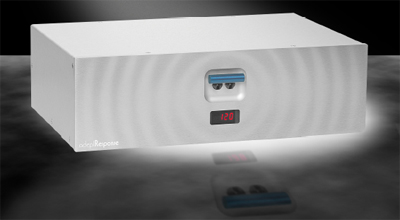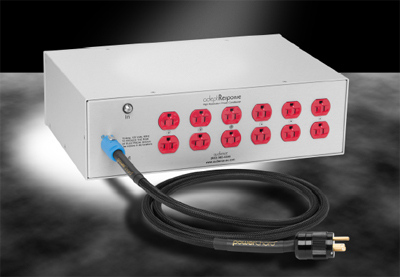You are reading the older HTML site
Positive Feedback ISSUE
18
march/april 2005
audience
adeptResponse line conditioner
as reviewed by Tom Campbell

|
TOM CAMPBELL'S SYSTEM
LOUDSPEAKERS
ELECTRONICS
SOURCES
CABLES
ACCESSORIES
|
Power conditioners are usually difficult to review. I have had several in my system, and their benefits were not only subtle and subjective, but involved tradeoffs. Some improved depth and clarity but compressed dynamics. Others rendered a warm midrange, but top and bottom extension was missing in action. The Audience adeptResponse line conditioner, on the other hand, has been easy to review. Its effect in my system was immediate, positive, and far from subtle. Without going through a laundry list of audio parameters, there was not one that was not improved, often dramatically.
I believe that Audience has solved the power conditioner conundrum that you have to lose a little to gain a little. While similar in appearance to much of its competition, the adeptResponse goes about its business quite differently, and in a manner proprietary to Audience. For one thing, the adeptResponse eschews MOV (Metal Oxide Varistor) design, a technology employed as either the first or second line of defense against power surges in most line conditioners. MOVs keep everything under control, but tend to put a bit of a chokehold on the proceedings. The sound is neat and tidy, but flat and compressed, lacking the proverbial breath of life.
The adeptResponse has that breath of life in spades. It brought crystal-clear clarity to my system, with every instrumental line perfectly delineated, but all that detail was delivered without the least bit of edge or etch. On the contrary, tonality was exceptionally sweet. Above all, the adeptResponse helped my system to deliver the most dynamically lively and wonderfully airy sound I've heard in my home. Top-end air is a quality that is hard to quantify, and manifests itself to different degrees in different components. With the adeptResponse, images "floated," in a way I've not experienced before.
The results were—to use a hoary audiophile cliché—revelatory. Thomas Beecham's famous mid-‘50s Scheherazade is acknowledged as a classic performance, but is not a great recording. It has always sounded distant and murky to me, but the adeptResponse cleared the murk to reveal a recording that, for the first time, could almost rival contemporaneous early stereo recordings from RCA and Decca.
The adeptResponse helped tell me exactly what was going on in a recording, which can be both a good and a bad thing. A simple two-microphone recording like the Rubinstein/Reiner Brahms Piano Concerto No. 1 (Classic/RCA LP reissue) sounded magnificent within its bandwidth limitations, but the new SACD of Hilary Hahn's Elgar Violin Concerto (DG) made the use of multi-mic'ing very obvious, with most instruments right in your face. I like this performance very much, but the recording lacks the orchestral blend you hear in the concert hall.
Before giving an almost unqualified rave to a power conditioner that costs $3800, I got my hands on a Monster Power HTS-5100 Signature line conditioner, which, at $800, is near the top of Monster's line. Like the adeptResponse, the Monster is a rack-mount component, with more than enough outlets to power your entire system and a central display that shows incoming voltage from your wall. While different on the inside, the appearance of the two line conditioners is almost identical.
The HTS-5100 Signature is a fine unit, with a better build quality than the adeptResponse. I was hoping it could come close to equaling the Audience unit's performance at a fraction of the price, but while it gave the adeptResponse a decent run for its money, alas, there is no free lunch. Compared to the adeptResponse, the 5100 sounded dynamically restricted, and contributed to a bass-heavy sound that was a bit short on top-end extension. The magically alive sound of the adeptResponse just wasn't there. I probably would have been pretty happy without the Audience for comparison. The Monster unit's clarity and detail were impressive, but I was cognizant at all times of the fact that I was listening through an electronic medium, an effect the adeptResponse transcends better than any component I've heard.
My only caveat is that, in my experience, power conditioners are exceptionally system-dependent. An audition period is necessary to see if a given unit is compatible with your components. Also—and I'm playing devil's advocate here—I'd imagine that if your system has lean, sharp tendencies, the adeptResponse could prove antiseptic. As far as I can tell, it does not add any character of its own. Rather, because it cleans the gunk from your power line, your components produce the kind of fast and lively sound of which they have always been capable. The final result was that the adeptResponse gave me an even deeper admiration for the excellence of my mid-priced but high-performance components. The ultra-wide bandwidth and top-to-bottom neutrality of my Coda/Continuum integrated amp was awesome, and the slightly warmer character of my Marsh separates was almost equally fine.
I‘m sure that there are some readers who aren't buying what I'm selling, and who believe that power conditioners are among the many examples of audiophile fool's gold. I respectfully disagree. I try to be un-neurotic about my system, but in my experience, line conditioners have a pronounced effect. Obviously, the musical signal never passes through a line conditioner. Its only aim is to improve the delivery of current to your amplifier and source components, but it seems very apparent to me that that's not nuthin'.
While $3800 may be an awful lot of money to spend on a power conditioner, the Audience adeptResponse made a powerful argument for inclusion in my mid-priced (at least compared to other PFO reviewers—we will have several takes on the adeptResponse from other PFO reviewers in the coming months - Ed.) system. Unfortunately, having just gone through an expensive move, I cannot buy the adeptResponse at present, but it will be the hardest to return of all the components I've reviewed. Tom Campbell

adeptResponse
Retail: $3800
Audience
web address: www.audience-av.com
